#travelphotography. The beach. Playa de Bayas. #Asturias. Winter. @TurismoAsturias ,#landscapelovers, #nature, #photography, #travel, #photooftheday,
La Isla de La Deva y Playón de Bayas
es un conjunto declarado monumento natural situado en el Principado de
Asturias, en terrenos del concejo de Castrillón y Soto del Barco, al
este de la desembocadura del río Nalón.
El Playón de Bayas,
con casi 3 km de longitud, es el arenal más largo de Asturias. Su
formación no es fortuita. Es debida a la gran cantidad de sedimentos que
arrastra el río Nalón, que drena casi dos tercios de la región
asturiana, y que se sitúa al oeste de la playa. Las corrientes litorales
dominantes en el mar Cantábrico,
de oeste a este, arrastran estos sedimentos haciéndolos tropezar con el
resalte del Cabo Vidrias y depositándolos sobre el arenal de Bayas, lo
que da lugar a la formación de un importante sistema dunar, sólo
interrumpido por la desembocadura del arroyo de Fontebona, que deslinda
los concejos de Soto del Barco y Castrillón
En (google translate)
The Island of La Deva and Playon de Bayas is declared a natural monument located in the Principality of Asturias, on land in the municipality of Castrillón and Soto del Barco, east of the mouth of the river Nalon whole.
Playon de Bayas, with nearly 3 km in length, is the longest beach of Asturias. Its formation is not random. It is due to the large amount of sediment carried by the Nalon River, which drains about two thirds of the Asturias region, which is located west of the beach. The dominant longshore currents in the Bay of Biscay, west to east, dragging these sediments making them trip over the Cape highlight Vidrias and depositing them on the beach of Bayas, leading to the formation of an important dune system, interrupted only by the Fontebona mouth of the stream, which separates the municipalities of Soto del Barco and Castrillón
R201512
Recuerde que haciendo click en la foto se ve a mayor tamaño
Playon de Bayas, with nearly 3 km in length, is the longest beach of Asturias. Its formation is not random. It is due to the large amount of sediment carried by the Nalon River, which drains about two thirds of the Asturias region, which is located west of the beach. The dominant longshore currents in the Bay of Biscay, west to east, dragging these sediments making them trip over the Cape highlight Vidrias and depositing them on the beach of Bayas, leading to the formation of an important dune system, interrupted only by the Fontebona mouth of the stream, which separates the municipalities of Soto del Barco and Castrillón
R201512
Recuerde que haciendo click en la foto se ve a mayor tamaño






